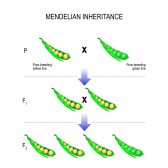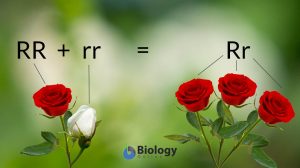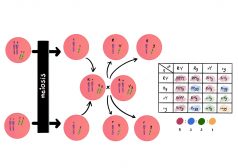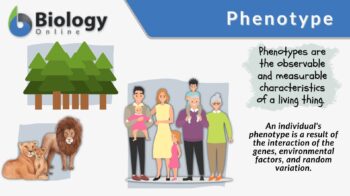
Phenotype
n., plural: phenotypes
[ˈfiːnəʊˌtaɪp]
Definition: observable and measurable characteristics of an organism
Table of Contents
Phenotype refers to the observable characteristics of an organism as a multifactorial consequence of genetic traits and environmental influences. The organism phenotype includes its morphological, biochemical, physiological, and behavioral properties.
Therefore, the phenotype is the total characteristics displayed by an organism that results from the expression of the genes of an organism as well as the influence of environmental factors and random variation. The interaction between these factors has often been represented by the following relationship: genotype + environment + random variation → phenotype.
Let’s talk about phenotype! Join our Forum discussion: Incomplete dominance vs. codominance. Be part of our community!
Phenotype Definition
In biology, ”phenotype” is defined as the observable and measurable characteristics of an organism as a result of the interaction of the genes of the organism, environmental factors, and random variation. The phenotype of an organism will not only entail the observable features such as morphology but it will also include molecules and structures such as RNA and proteins produced as coded by the genes; this is referred to as ”molecular phenotype”.
Etymology
The term phenotype came from the Latin phaeno- , from Greek phaino- , meaning “shining”, from phaínein, meaning “to shine”, “to appear”, “to show”, and -type from “typos”. Compare: genotype. The term phenotypic is a descriptive word that is used to pertain, relate to, or describe the phenotype of a particular organism.
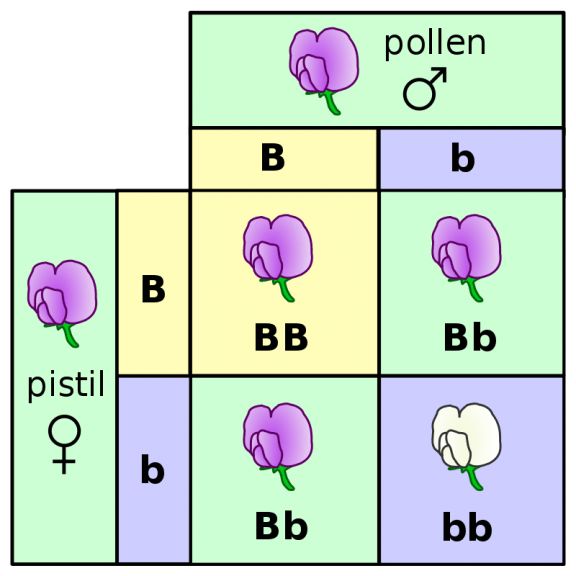
Trait vs. Phenotype
A trait is an attribute of the organism’s phenotype. Thus, in genetics, the trait is also referred to as the phenotypic trait, to distinguish one trait from another within the more-inclusive term, phenotype. The phenotype of an organism is comprised of different traits. The traits may be inherited (genetically determined), acquired due to environmental influences, or the result from the interaction of the two. For instance, the hair color is a character in which the traits could be black, blonde, ginger, or brunette.
Phenotype vs. Genotype
In genetics, genotype and phenotype are common terms used to explicate the appearance, function, and behavior of an organism. A genotype is defined as the set of genes that when expressed determines the characteristic or the trait of the organism. In simpler words, the genotype is the genetic contribution to the phenotype.
The genes make up the sequences of DNA. In humans and other organisms, they occur in pairs – one coming from the male parent and the other from the female parent. The pairs of genes occupying the same loci on the chromosomes and controlling the same trait are called alleles. So, how are alleles and traits related?
Typically, a pair of genes (or a pair of alleles) for a particular trait is comprised of two, one is dominant and the other, recessive. The dominant allele will be expressed as a trait whereas the recessive allele will not be expressed. Annotating the dominant allele with A and the recessive allele with a, there could be three possible genotypes: (1) AA, the homozygous dominant allele, (2) Aa, the heterozygous dominant, and (3) aa, the homozygous recessive. The genotype of an organism is a major determinant of the phenotype of an organism.
But how does genotype affect phenotype? Let’s take for instance the pair of alleles (or pair of genes) that determines a particular trait where one of them is dominant (A) and the other, recessive (a). The dominant allele (A) will be expressed and become a part of the phenotype of the organism whereas the effect of the recessive allele (a) will be masked.
When a trait follows Mendelian inheritance, the A will manifest as a trait whereas a will not. Thus, the phenotype of an organism shall include the traits of all the expressed genes. In humans though, many of the observable traits are more complex than those that follow the Mendelian pattern. Complex traits, such as height and skin color, are brought about by the interactions of multiple alleles, as in the case of polygenic inheritance.
Let’s learn the different phenotype traits! Join our Forum discussion: Incomplete dominance vs. codominance.
Expression
The phenotype is the result of genetic factors, environmental influences, and random genetic variations. When the pair of alleles determining a particular trait consists of the same genes, e.g. AA or aa, the trait is described as homozygous. When the allelic composition consists of different genes, e.g. Aa, the trait is described as heterozygous. The presence of the dominant allele, i.e. AA or Aa, will result in the manifestation of the trait (A) whereas the absence of the dominant allele, i.e. aa, will result in the expression of the other trait (a). This is a case of complete dominance and it follows the Mendelian inheritance.
In cases of codominance, incomplete dominance, and polygenic inheritance, the manifestation of a trait will not follow the Mendelian pattern. For instance, in codominance, the alleles of a gene pair in a heterozygote will be fully expressed since both alleles in a pair are dominant (e.g. AB). In incomplete dominance, the resulting trait will be an intermediate of the effects of the two alleles. This is because the dominant allele will only be partially expressed. As a result, the heterozygous offspring will show a phenotype that is intermediate to the phenotype of the parents.
Apart from the genetic interactions, the phenotype of an organism will also depend on the influence of the environment and random (genetic) variations. Exposure to environmental factors could affect the appearance of an organism. For instance, a light-colored skin that is constantly exposed to the sun’s rays will cause the skin to darken from increased melanin production.
As for random variation, the genetic mutation could alter the physical trait or at least the fitness of an organism. Changes in the genes are essential as they drive evolution and natural selection. Genotypes, environmental effects, and genetic variations help explain why individuals tend to have different phenotypes.
Extreme Phenotype
An extreme phenotype arises when the parents’ alleles come together and result in a hybrid with a phenotype that is greater or higher than the phenotypes of its parents. Its transgressive phenotype may be beneficial or detrimental depending on how it affects the overall fitness of the offspring. The formation of extreme phenotypes is called transgressive segregation. An example of a hybrid with an extreme phenotype is the offspring from a cross between Helianthus annuus and Helianthus petiolaris. The two sunflower species produced hybrids that have transgressive traits. The hybrids, as opposed to their parents, are able to thrive in areas where their parents cannot. They are able to survive in sand dunes and salt marshes. (Ref.1)
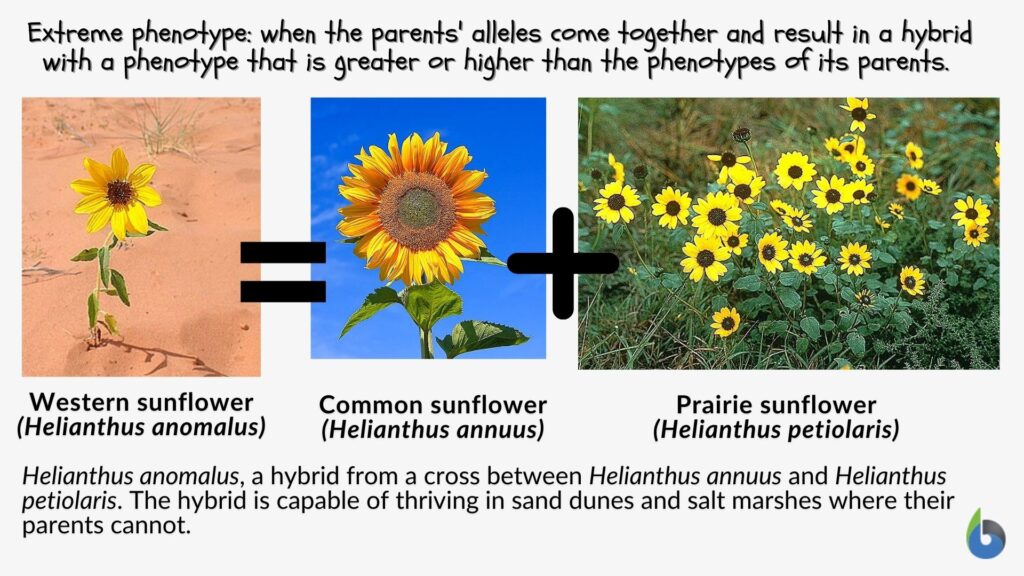
Recombinant Phenotype
Meiosis is one of the important biological events that lead to greater variation in the phenotypes of organisms. Particularly, during the metaphase of meiosis I, the homologous chromosomes come together to exchange genes via homologous recombination. As the homologous chromosomes reach the end of meiosis (telophase II), the four daughter cells will have chromosomes distinct from one another. Some of them will become gametes containing recombinant genes. When such gamete is fertilized with a wild type, for instance, it will develop into an offspring with a recombinant phenotype, i.e. a phenotype that is different from the phenotypes of its parents.
How to determine the phenotype of recombinants? A test-cross on two traits (e.g. blue-bodied, normal-winged fly parent and black-bodied, vestigial-winged fly parent) can help identify recombinant phenotypes. The offspring with phenotypes different from the parents (e.g. blue-bodied, vestigial-winged fly, or black-bodied, normal-winged fly) indicate that they are recombinants.
Phenotypic Ratio
A Punnett square is another tool that can be used to identify all possible allelic combinations in a test cross. It can predict the genotypes and the phenotypes of the offspring. It is a diagram in grids and letters to represent alleles. An uppercase letter (e.g. A) denotes a dominant trait or genotype and a lowercase denotes a recessive trait or genotype (e.g. a). Based on the Punnett square, the phenotypic ratio (as well as the genotypic ratio) can be determined.
A phenotypic ratio is a ratio that can be predicted from a test cross. It can be known based on the phenotypes of the offspring, i.e. the frequency of offspring manifesting different traits or trait combinations. For example, the expected phenotypic ratio of AaBb x aabb dihybrid cross (i.e. a cross that deals with two characters, e.g. body color – A for blue, a for black) and wing morphology – B for normal wings, b for vestigial wings) is 1:1:1:1, based on the four possible different phenotypes: AaBb (blue, normal-winged fly), aaBb (black, normal-winged fly), Aabb (blue, vestigial-winged fly), and aabb (black, vestigial-winged fly).
Read: Dominance – Biology Tutorials
What is the phenotype of incomplete dominance? How about codominance? Tell us what you think! Join our Forum: Incomplete dominance vs. codominance.
Examples
As pointed earlier, the phenotype of an organism refers to the various traits an organism possesses. Examples are blue eye trait (for eye color character), brown skin trait (for skin color character), long-tail trait (for tail character), five-petalled trait (for flower character), etc. Behavior is also a phenotype example. For example, the behavior and cognitive traits of individuals with mental retardation are behavioral phenotypes. (Ref.2)
NOTE IT!
Nature’s Phenotypic “Makeovers”
Nature is a creative cradle of ingenious organisms that found their way to survival success by being phenotypically flexible. Living things are such dynamic entities capable of changing and adjusting themselves to certain extent to better suit their surroundings. Such an ability to undergo phenotypic “makeovers” in response to changes in their environment is what phenotypic plasticity is about. It allows them to adjust their physical and physiological traits based on perceived environmental or developmental cues without necessarily chainging the underlying genetic code (genotype). Here are few of the multifarious examples:
- Butterflies developing wing patterns and size based on temperature they were exposed to during their pupal stage, e.g., developing larger wings cued by warm temperatures
- Ambient temperature predicting the sex of the developing embryo of some reptiles, such as american alligator (Alligator mississippiensis), common garter snake (Thamnophis sirtalis), and red-eared slider turtle (Trachemys scripta elegans)
- Coat or fur color chainging with the seasons, e.g., arctic fox donning a white fur in winter season to match their snowy environment and then brown, gray, or red in summer to blend in with tundra vegatation.
Try to answer the quiz below to check what you have learned so far about phenotypes.
Further Reading
References
- Schwarzbach, A. E., Donovan, L. A. and Rieseberg, L. H. (2001). “Transgressive character expression in a hybrid sunflower species.” American Journal of Botany 88.2: 270–277.
- Csábi, G., & Tényi, T. (2006). Behavioral phenotypes and cognitive characteristics in mental retardation. Neuropsychopharmacologia Hungarica : A Magyar Pszichofarmakologiai Egyesulet Lapja = Official Journal of the Hungarian Association of Psychopharmacology, 8(3), 127–142. Retrieved from https://www.ncbi.nlm.nih.gov/pubmed/17211048
© Biology Online. Content provided and moderated by Biology Online Editors.

